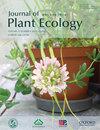Seasonal grazing alters nutrient resorption and conservation, and affects spring growth of Stipa grandis
IF 3.9
2区 环境科学与生态学
Q2 ECOLOGY
引用次数: 0
Abstract
Nutrient resorption in autumn is a key mechanism of perennial plants for nutrient conservation and efficient use in grassland. Grazing effects on plant nutrient resorption may alter root nutrient conservation and affect plant growth in the subsequent spring. There are many studies on nutrient resorption and conservation of plants in grazing grassland, but few studies on its effect on plant growth in subsequent spring. Taking Stipa grandis, a dominant perennial grass in a semi-arid steppe as a model plant, we examined plant nitrogen (N) and phosphorous (P) resorption traits (resorption efficiency, proficiency and flux) and root nutrient conservation traits (root biomass and nutrient pool) in autumn, and plant growth traits (height, biomass and nutrient pool) in the subsequent spring, in an experimental grassland under four grazing-season treatments (i.e., grazing in spring, summer or autumn, or no grazing). We found that (1) 51-66% of N and 58-80% of P in S. grandis shoots were resorbed in autumn, and the resorption flux was the lowest under autumn grazing, and highest under spring grazing. (2) Root nutrient conservation traits were significantly reduced by summer grazing, slightly decreased by spring grazing, but not affected by autumn grazing. (3) Plant growth in next spring was the best under early spring grazing and the worst under autumn grazing, which was mainly affected by soil moisture rather than root nutrient storage. Our study provides insights into the process of plant nutrient cycling and a theoretical basis for establishing grazing system for grassland protection and rational utilization.季节性放牧改变了大针茅养分的吸收和保存,影响了大针茅的春季生长
秋季养分吸收是多年生植物在草地上保持和有效利用养分的关键机制。放牧对植物养分吸收的影响可能会改变根系养分的保存,并影响植物在下一个春天的生长。关于放牧草地植物养分吸收和保护的研究很多,但对其对来年春季植物生长的影响研究很少。以半干旱草原的优势多年生草本大针茅为模式植物,研究了秋季植物氮磷吸收特征(吸收效率、利用率和通量)和根系养分保持特征(根系生物量和养分库),以及随后春季的植物生长特征(高度、生物量和营养库),在四个放牧季节处理(即春季、夏季或秋季放牧,或不放牧)的实验草原中。结果表明:(1)香茅幼芽在秋季吸收了51-66%的N和58-80%的P,秋季放牧吸收通量最低,春季放牧吸收通量最高。(2) 夏季放牧显著降低了根系养分保持性状,春季放牧略有降低,但秋季放牧不影响根系养分保持特性。(3) 早春放牧条件下植物生长最好,秋季放牧条件下生长最差,主要受土壤水分而非根系养分储存的影响。我们的研究为深入了解植物养分循环过程提供了理论依据,为建立草地保护和合理利用的放牧制度提供了理论基础。
本文章由计算机程序翻译,如有差异,请以英文原文为准。
求助全文
约1分钟内获得全文
求助全文
来源期刊

Journal of Plant Ecology
生物-植物科学
CiteScore
4.60
自引率
18.50%
发文量
134
审稿时长
3 months
期刊介绍:
Journal of Plant Ecology (JPE) serves as an important medium for ecologists to present research findings and discuss challenging issues in the broad field of plants and their interactions with biotic and abiotic environment. The JPE will cover all aspects of plant ecology, including plant ecophysiology, population ecology, community ecology, ecosystem ecology and landscape ecology as well as conservation ecology, evolutionary ecology, and theoretical ecology.
 求助内容:
求助内容: 应助结果提醒方式:
应助结果提醒方式:


